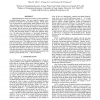Free Online Productivity Tools
i2Speak
i2Symbol
i2OCR
iTex2Img
iWeb2Print
iWeb2Shot
i2Type
iPdf2Split
iPdf2Merge
i2Bopomofo
i2Arabic
i2Style
i2Image
i2PDF
iLatex2Rtf
Sci2ools
104
Voted
ICMCS
2006
IEEE
2006
IEEE
Removing Shadows using Flash/Noflash Image Edges
Flash/noflash pairs have been used for noise-reduction in ambient-light images. But not explicitly studied is the problem of shadows in the ambient images. While shadows are lessened in a flash image, other problems arise, and other shadows are produced. It is known that we can in fact produce a flash-only (no ambient) image by subtracting the two images, but the result is not as pleasant as the ambient image, because of several artifacts due to the flash. Here, we use the pure-flash image to detect the ambient shadows. We argue that first going to a “spectrally sharpened” color space, and then focusing on the difference in a log domain of the flash image minus the ambient image, gives a very simple feature space consisting of two components — one in an illuminant-change 3-vector direction, and one along the gray axis. This space provides excellent separation of the shadow and nonshadow areas. Inserting edges from the flash image within the ambient-shadow region into the...
Related Content
| Added | 11 Jun 2010 |
| Updated | 11 Jun 2010 |
| Type | Conference |
| Year | 2006 |
| Where | ICMCS |
| Authors | Mark S. Drew, Cheng Lu, Graham D. Finlayson |
Comments (0)

